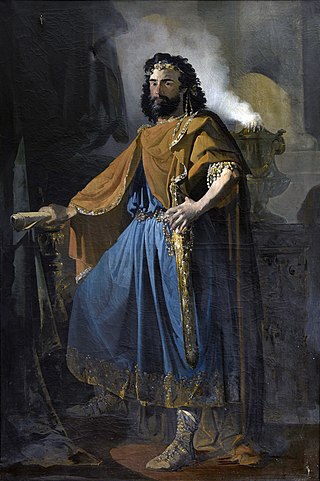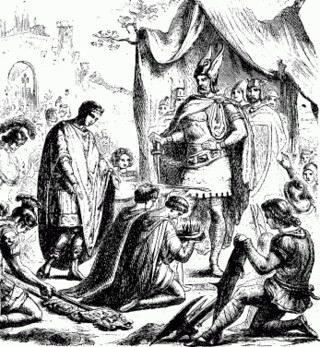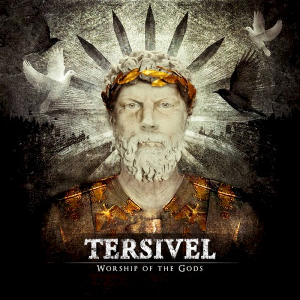
Edward Gibbon was an English essayist, historian, and politician. His most important work, The History of the Decline and Fall of the Roman Empire, published in six volumes between 1776 and 1788, is known for the quality and irony of its prose, its use of primary sources, and its polemical criticism of organised religion.

The History of the Decline and Fall of the Roman Empire is a six-volume work by the English historian Edward Gibbon. It traces Western civilization from the height of the Roman Empire to the fall of Byzantium in the fifteenth century. Volume I was published in 1776 and went through six printings. Volumes II and III were published in 1781; volumes IV, V, and VI in 1788–1789.

The Four Horsemen of the Apocalypse are figures in the Book of Revelation in the New Testament of the Bible, a piece of apocalypse literature written by John of Patmos. They are not specifically identified there but subsequent commentary often identifies them as personifications of Death, Famine, War, and Conquest.

Euric, also known as Evaric, son of Theodoric I, ruled as king (rex) of the Visigoths, after murdering his brother, Theodoric II, from 466 until his death in 484. Sometimes he is called Euric II.

Marcus Aurelius Carus was Roman emperor from 282 to 283. During his short reign, Carus fought the Germanic tribes and Sarmatians along the Danube frontier with success.

The Fall of the Roman Empire is a 1964 American epic historical drama film directed by Anthony Mann and produced by Samuel Bronston, with a screenplay by Ben Barzman, Basilio Franchina and Philip Yordan. The film stars Sophia Loren, Stephen Boyd, Alec Guinness, James Mason, Christopher Plummer, Mel Ferrer, and Omar Sharif.

On the City of God Against the Pagans, often called The City of God, is a book of Christian philosophy written in Latin by Augustine of Hippo in the early 5th century AD. The book was in response to allegations that Christianity brought about the decline of Rome and is considered one of Augustine's most important works, standing alongside The Confessions, The Enchiridion, On Christian Doctrine, and On the Trinity. As a work of one of the most influential Church Fathers, The City of God is a cornerstone of Western thought, expounding on many questions of theology, such as the suffering of the righteous, the existence of evil, the conflict between free will and divine omniscience, and the doctrine of original sin.

The fall of the Western Roman Empire, also called the fall of the Roman Empire or the fall of Rome, was the loss of central political control in the Western Roman Empire, a process in which the Empire failed to enforce its rule, and its vast territory was divided into several successor polities. The Roman Empire lost the strengths that had allowed it to exercise effective control over its Western provinces; modern historians posit factors including the effectiveness and numbers of the army, the health and numbers of the Roman population, the strength of the economy, the competence of the emperors, the internal struggles for power, the religious changes of the period, and the efficiency of the civil administration. Increasing pressure from invading barbarians outside Roman culture also contributed greatly to the collapse. Climatic changes and both endemic and epidemic disease drove many of these immediate factors. The reasons for the collapse are major subjects of the historiography of the ancient world and they inform much modern discourse on state failure.

The causes and mechanisms of the fall of the Western Roman Empire are a historical theme that was introduced by historian Edward Gibbon in his 1776 book The History of the Decline and Fall of the Roman Empire. Though Gibbon was not the first to speculate on why the empire collapsed, he was the first to give a well-researched and well-referenced account of the event, and started an ongoing historiographical discussion about what caused the fall of the Western Roman Empire. The traditional date for the end of the Western Roman Empire is 476 when the last Western Roman Emperor was deposed. Many theories of causality have been explored. In 1984, Alexander Demandt enumerated 210 different theories on why Rome fell, and new theories have since emerged. Gibbon himself explored ideas of internal decline and of attacks from outside the empire.

The Nerva–Antonine dynasty comprised seven Roman emperors who ruled from AD 96 to 192: Nerva (96–98), Trajan (98–117), Hadrian (117–138), Antoninus Pius (138–161), Marcus Aurelius (161–180), Lucius Verus (161–169), and Commodus (180–192). The first five of these are commonly known as the "Five Good Emperors".
A snowclone is a cliché and phrasal template that can be used and recognized in multiple variants. The term was coined as a neologism in 2004, derived from journalistic clichés that referred to the number of Inuit words for snow.
Rise and Fall may refer to:
Decline and Fall is a novel by the English author Evelyn Waugh, first published in 1928.

The Battle of Ravenna, capital of the Western Roman Empire, between the Heruli under their King Odoacer and the remnants of the Western Roman army in Roman Italy occurred in early September 476, and represented a culminating event in the ongoing fall of the Western Roman Empire. The Roman Empire had been in relative decline since the beginning of the barbarian invasions and Rome, the symbolical heart and largest city of the Western Empire, was sacked in 410 by the Visigoths and in 455 by the Vandals. By 476 the Roman emperor was little more than a puppet, having very little de facto control of any territory outside of Italy. The last Roman emperor, Romulus Augustulus, was not recognized as a legitimate ruler outside of Italy; the Eastern Roman Empire recognized Julius Nepos as the true Western Roman Emperor.

Odoacer's deposition of Romulus Augustus, occurring in 476 AD, was a coup that marked the end of the reign of the Western Roman Emperor last approved by the Western Roman Senate and the creation of the Kingdom of Italy, although Julius Nepos exercised control over Dalmatia until 480.
The Siege of Florence was a battle that took place in 405 or 406 AD between the Goths and the Roman Empire in Florence.
Decline and fall of the Roman Empire may refer to:

Considerations on the Causes of the Greatness of the Romans and their Decline is an 18th-century book written by French political philosopher Montesquieu. First published in 1734, it is widely considered by scholars to be among Montesquieu's best known works and was an inspiration to Edward Gibbon's more extensive The History of the Decline and Fall of the Roman Empire.

Worship of the Gods is the second full-length album by Argentine pagan metal, folk metal band Tersivel. The album was released on October 27, 2017. The album refers to Julian, also known as Julian the Apostate, who was Roman Emperor from 361 to 363. He purged the top-heavy state bureaucracy and attempted to revive traditional Roman religious practices at the expense of Christianity.
The Rise and Fall of is an English snowclone popularly used in titles of works. Examples of its usage include: